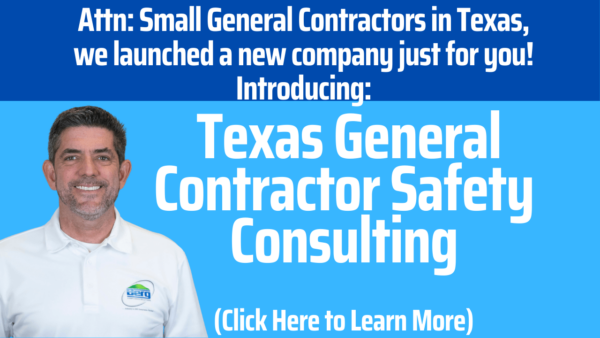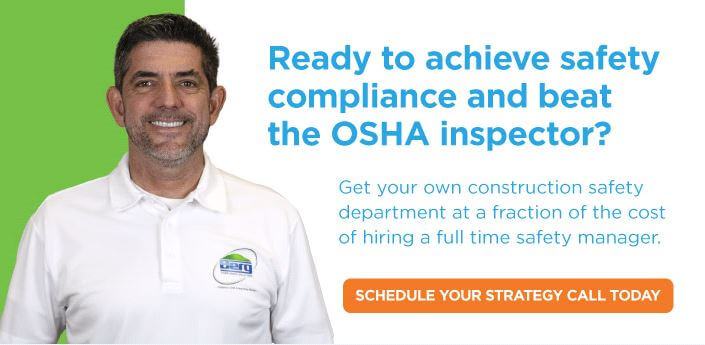The Top 10 Construction Safety Violations
Day after day, week after week, month after month, and year after year, OSHA inspects and fines small construction companies across the country for the same violations, which often adds up to $10s or even $100s of thousands worth of fines per inspection.
Unless you’re sure that your projects are keeping up, it’s vital that you take action and get prepared.
With that in mind, here are the Top 10 construction violations that you need to be aware of:
- Duty to Have Fall Protection
- General Scaffold Requirements
- Ladders
- Fall Protection Training Requirements
- PPE: Eye & face requirements
- General Health & Safety Provisions
- Personal Protective Equipment: Head Protection
- Excavation Provisions
- Aerial Lifts
- Fall Protection Systems Criteria & Practices
Read below to learn more about each of these violations and how to avoid them.
The #1 Construction OSHA Violation
Without question, the #1 cause of construction fatalities, and serious injuries, year after year are falls from heights.
According to OSHA laws, all construction work above 6’ requires a long list “Fall Protection” requirements designed to protect workers from falls and falling objects.
Within these requirements are “Duty To Have Fall Protection” laws which require general contractors and subs to conduct routine inspections to identify and correct fall hazards.
Unfortunately, many small construction companies struggle to manage fall protection laws due to a common lack of expertise, time and resources, but OSHA doesn’t care about these challenges and routinely issues fines that run into the $10s or even $100s of thousands of dollars per inspection. Even to very small companies.
This makes “Duty to Have Fall Protection” the #1 construction violation in Texas.
The stakes for failing to manage Fall Protection are just too high.
The #2 Construction OSHA Violation
Scaffolding violations rank just behind Fall Protection when it comes to failed OSHA inspections at many small construction projects.
While driving around town and throughout the state, I routinely see serious scaffolding violations on both residential and small commercial construction projects.
In fact, I can’t remember the last time I saw a “compliant scaffold” on one of these projects.
The most common violations include deficient planks, lack of toeboards and lack of guard rails.
These non-compliant “scaffolds” are extremely dangerous and put the project general contractor and subcontractors at major risk for huge fines, serious injuries and even fatalities.
These common violations make “General Scaffold Requirements” the #2 construction violation in Texas.
Checkout this OSHA page to learn more about General Scaffold Requirements and how to manage them.
https://www.osha.gov/laws-regs/regulations/standardnumber/1926/1926.451
The #3 Construction OSHA Violation
Go to any construction project, and you’ll find ladders of all types including self supporting, extension and fixed ladders.
The problem is that many of them are probably non-compliant for a variety of reasons including being damaged or having unreadable or missing labels.
These seemingly harmless issues can lead to major accidents, injuries and even fatalities.
OSHA has a long list of Ladder safety laws that construction companies must manage or face major fines and penalties.
Believe it or not, a single unreadable or missing label can result in a “Serious” violation costing up to $13,500!
These factors make Ladders the #3 construction violation in Texas.
Learn more about OSHA Ladder safety laws and how to manage them here.
https://www.osha.gov/laws-regs/regulations/standardnumber/1926/1926.1053
The #4 Construction OSHA Violation
As mentioned earlier in this series of construction violation emails, falls from heights are by far the #1 cause of serious injuries and deaths year after year at construction sites.
In order to mitigate these serious fall hazards, OSHA has a long list of Fall Protection requirements that general contractors and subcontractors must understand and follow, including extensive training requirements.
These include general awareness training and in many cases very specific fall protection PPE use training, certifications and routine re-training.
It’s not easy to keep up, and the fact is that very few workers at small construction companies ever receive this training, which can lead to major problems.
These challenges make Fall Protection training the #4 construction violation in Texas.
Learn more about Fall Protection training requirements on OSHA’s website.
https://www.osha.gov/laws-regs/regulations/standardnumber/1926/1926.503
The #5 OSHA Construction Violation
Many common construction activities, such as cutting, chemical use, equipment operation and even heat exposures, can lead to serious injuries of the eyes and face.
General contractors and subcontractors are required to assess all of these task hazards and then provide appropriate PPE to workers in order to protect them.
Common PPE includes face shields, goggles and safety glasses.
But that’s not all, employers are also required to enforce use of this PPE at all times while work is being conducted. This includes a requirement for General Contractors to hold their subcontractors accountable.
As simple as this sounds, few small construction companies are actually able to keep up with these requirements, making Eye and Face protection PPE the #5 construction violation in Texas.
Learn more about face and eye PPE OSHA laws here.
https://www.osha.gov/laws-regs/regulations/standardnumber/1926/1926.102
The #6 Construction OSHA Violation
Until now, all of the violations covered in this series were relatively specific, including Fall Protection, Scaffolding and PPE requirements, but now we arrive at a much broader violation called “General Safety & Health Provisions.”
I’ve copied and pasted the law below directly from OSHA’s website:
“Requirements include contracting to prevent workers from working in surroundings or conditions that are unsanitary, hazardous or dangerous to their health and safety, which includes identifying compliance duties and accident prevention responsibilities.”
To state in simpler terms, the law covers everything from dirty bathroom facilities, to unsafe equipment and tools, to Lockout/Tagout requirements, to unprotected trenches, and much, much more.
Again, the provision is very broad and therefore puts an enormous burden on small construction companies to try and keep up. This is especially true for General Contractors, who are responsible for the overall health and safety of their projects.
This makes General Safety & Health Provisions the #6 construction OSHA violation in Texas.
Learn more about this law and how to manage it on OSHA’s website.
https://www.osha.gov/laws-regs/regulations/standardnumber/1926/1926.20
The #7 Construction OSHA Violation
In addition to the eye and face injury hazards discussed in a previous email, construction activities also pose serious safety risks to the head.
These include objects falling from above, flying debris, heavy equipment and hand tool operation and many other “struck by” hazards.
The good news is that most, if not all of these hazards, can be managed by simply providing and wearing the appropriately rated hard hat.
Just like with other PPE requirements, it sounds simple enough yet many small general contractors and subcontractors fail to keep up, making Head Protection the #7 construction OSHA violation in Texas.
Learn all about OSHA head protection laws in this section from their website.
https://www.osha.gov/laws-regs/regulations/standardnumber/1926/1926.100
The #8 Construction OSHA Violation
All OSHA violations 1-7 discussed so far in this series have to do with “above ground” construction safety hazards, however violation #8 involves “below ground” violations having to do with excavations.
Failure to manage excavation safety can result in fatalities and serious injuries caused by cave-ins or unsafe atmospheres. Cave-ins are by far the greatest risk, and result in hundreds of preventable deaths and serious every year on Texas construction sites.
In general, OSHA excavation requirements trigger when an excavation is > 5’ deep unless the excavation is created entirely in solid rock. These safety requirements include mandates to provide protection from cave-ins, conducting atmospheric testing prior to entry, providing safe access and egress, as well as providing rescue equipment and planning.
Learn about excavation safety on OSHA’s website
https://www.osha.gov/sites/default/files/publications/osha2226.pdf
The #9 Construction OSHA Violation
Go to just about any construction project, and you’ll likely see numerous aerial lifts scattered throughout the site.
They’re often referred to as boom platforms, aerial ladders or tower trucks.
These lifts are great for providing workers access to upper sections of buildings that can’t otherwise be safely reached, but can also be extremely dangerous if not managed and used correctly.
Just like forklifts, aerial lifts require a long list of OSHA requirements including special training, safe operation, routine inspections and sometimes PPE.
And also just like forklifts, small construction companies struggle to manage these requirements making Aerial lifts the #9 Construction OSHA violation.
Learn more about aerial lift safety on OSHA’s website.
https://www.osha.gov/laws-regs/regulations/standardnumber/1926/1926.453
The #10 OSHA Construction Violation
As mentioned before, by far the #1 cause of construction fatalities, and serious injuries, year after year are falls from heights.
According to OSHA laws, all construction work above 6’ requires a long list “Fall Protection” regulations designed to protect workers from falls and falling objects.
In addition to the training and inspection requirements covered in a previous email, other fall protection laws including requirements to provide safety nets, guardrail systems, and specialized personal fall arrest systems.
These systems can be expensive, complex and therefore difficult to manage.
These common challenges make “Fall Protection Systems, Criteria and Practices” the #10 Construction OSHA violation in Texas.
In case you missed this above, I created this blog post to help small construction companies better understand OSHA fall protection requirements and related risks for failing to manage them.
Call 512-457-0374 or Click Below
To Schedule Your Free Safety Consultation



